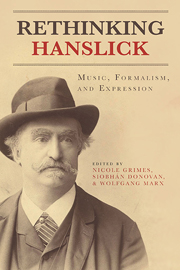Book contents
- Frontmatter
- Contents
- Foreword by Mark Evan Bonds
- Acknowledgments
- Abbreviations
- Chronology
- Introduction
- Part One Rules of Engagement
- 1 Negotiating the “Absolute”: Hanslick's Path through Musical History
- 2 Hanslick's Composers
- 3 Hanslick, Legal Processes, and Scientific Methodologies: How Not to Construct an Ontology of Music
- 4 Otakar Hostinský, the Beautiful, and the Gesamtkunstwerk
- Part Two Liberalism and Societal Order
- Part Three Memoirs and Meaning in Social Contexts
- Part Four Critical Battlefields
- Selected Bibliography
- List of Contributors
- Index
1 - Negotiating the “Absolute”: Hanslick's Path through Musical History
from Part One - Rules of Engagement
Published online by Cambridge University Press: 05 July 2013
- Frontmatter
- Contents
- Foreword by Mark Evan Bonds
- Acknowledgments
- Abbreviations
- Chronology
- Introduction
- Part One Rules of Engagement
- 1 Negotiating the “Absolute”: Hanslick's Path through Musical History
- 2 Hanslick's Composers
- 3 Hanslick, Legal Processes, and Scientific Methodologies: How Not to Construct an Ontology of Music
- 4 Otakar Hostinský, the Beautiful, and the Gesamtkunstwerk
- Part Two Liberalism and Societal Order
- Part Three Memoirs and Meaning in Social Contexts
- Part Four Critical Battlefields
- Selected Bibliography
- List of Contributors
- Index
Summary
Introduction: The Path to Hanslick
Hanslick's name barely appears in current popular or everyday culture— and yet, most musicians do recognize “Hanslick,” albeit with an unmistakable bias in their reception. When performers, students, or even certain music historians and musicologists describe him, they most often provide an unflattering portrayal of a conservative, formalist aesthetician of absolute music on the one hand, a fearsome yet eminent critic with gigantic blind spots on the other.
Music appreciation texts—the sources of knowledge for thousands of undergraduates and their instructors in North America since they began appearing in the 1960s—have perpetuated the topos of Hanslick as the champion of abso¬lute music. For example, the definitive text by Grout, Palisca, and Burkholder, A History of Western Music (2006), characterized Hanslick as “the most articulate proponent of absolute music.” To substantiate this claim, the book juxtaposes a brief one-hundred-word passage from section 3 of Vom Musikalisch-Schönen with a longer paragraph from Liszt's essay on the Harold Symphony.
Regarding the other popular perception of Hanslick, as an errant purveyor of vitriol, the researcher could consider the writings of New Yorker critic and blogger Alex Ross—unofficial arbiter of taste for Generation X. Ross's blog The Rest Is Noise has consistently presented Hanslick as a critic whose conservative bias led him to misjudge contemporary composers, most notably in his “mistaken” reviews of Wagner and of Tchaikovsky's violin concerto.
- Type
- Chapter
- Information
- Rethinking HanslickMusic, Formalism, and Expression, pp. 15 - 37Publisher: Boydell & BrewerPrint publication year: 2013



